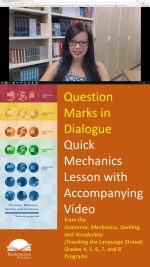Question Marks with Dialogue and Quotations
Question Marks with Dialogue and Quotations
Play the quick video lesson HERE and click the upper left back arrow to return to this lesson.
Common Core Language Standard 2
The question mark usually is one of the easiest punctuation marks to use properly–unless the question mark is used with quotations. Then, things get a bit trickier. Do we place the question mark inside or outside of the quotation marks?
Now let’s read the mechanics lesson and study the examples.
Place a question mark inside (to the left of) ending quotation marks (?”) when you, the writer, are quoting a question that was asked. Example: He asked, “Are you going, too?”
Place a question mark outside (to the right of) ending quotation marks (”?) when you, the writer, ask a question about a quotation. Example: Why did he say, “That’s not funny”?
Now circle or highlight what is right and revise what is wrong according to mechanics lesson.
Practice: Did she say, “I didn’t do it”? Or did she ask “Who did it”?
Let’s check the Practice Answers.
Mechanics Practice Answers: Did she say, “I didn’t do it”? Or did she ask “Who did it?”
Now let’s apply what we have learned.
Writing Application: Write two or your own sentences: the first one with a quote of a make-believe question that was asked and the second one with a question that you ask about a make-believe quotation.
This writing opener is part of a comprehensive language conventions lesson from the Grammar, Mechanics, Spelling, and Vocabulary Grades 4‒8 programs.
*****

Pennington Publishing Grammar Programs
Teaching Grammar, Usage, and Mechanics (Grades 4, 5, 6, 7, 8, and High School) are full-year, traditional, grade-level grammar, usage, and mechanics programs with plenty of remedial practice to help students catch up while they keep up with grade-level standards. Twice-per-week, 30-minute, no prep lessons in print or interactive Google slides with a fun secret agent theme. Simple sentence diagrams, mentor texts, video lessons, sentence dictations. Plenty of practice in the writing context. Includes biweekly tests and a final exam.
Grammar, Usage, and Mechanics Interactive Notebook (Grades 4‒8) is a full-year, no prep interactive notebook without all the mess. Twice-per-week, 30-minute, no prep grammar, usage, and mechanics lessons, formatted in Cornell Notes with cartoon response, writing application, 3D graphic organizers (easy cut and paste foldables), and great resource links. No need to create a teacher INB for student make-up work—it’s done for you! Plus, get remedial worksheets, biweekly tests, and a final exam.
Syntax in Reading and Writing is a function-based, sentence level syntax program, designed to build reading comprehension and increase writing sophistication. The 18 parts of speech, phrases, and clauses lessons are each leveled from basic (elementary) to advanced (middle and high school) and feature 5 lesson components (10–15 minutes each): 1. Learn It! 2. Identify It! 3. Explain It! (analysis of challenging sentences) 4. Revise It! (kernel sentences, sentence expansion, syntactic manipulation) 5. Create It! (Short writing application with the syntactic focus in different genre).
Get the Diagnostic Grammar, Usage, and Mechanics Assessments, Matrix, and Final Exam FREE Resource:
![]()

